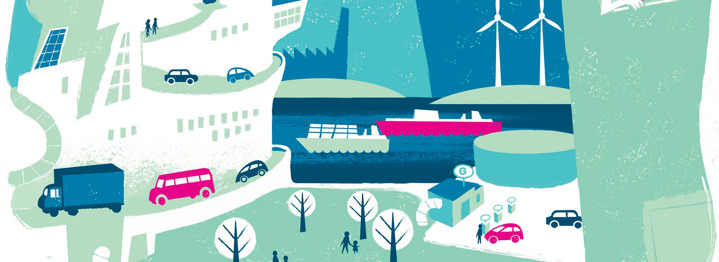-
Gasum
-
Gasum
-
Products and services
-
E-methane
E-methane – a synthetic and renewable gas
The demand for renewable gas is expected to increase rapidly in the next few years as both regulation and the market are incentivizing lower emission transportation in the maritime and land logistics segments. In just a couple of years, synthetic renewable e-methane will begin to complement biogas as a source of extremely low emissions energy where direct electrification is not a feasible option.
As the amount of affordable wind and solar power available in the Nordic electricity grid increases, using variable renewable electricity to produce renewable e-fuels is becoming a feasible way of storing energy and distributing it to sectors such as maritime and heavy road transportation, where direct electrification is not a realistic way of decarbonization.
Renewable e-methane can be produced already today synthetically through the Power-to-Gas process. First hydrogen is produced using renewable electricity and water. The resulting hydrogen is then further processed into methane by combining it with carbon dioxide.
The used carbon dioxide can be captured from various processes in, for example, waste management or the forestry industry. The e-methane produced in this way is significantly lower in emissions compared to fossil fuels. Its emissions reduction potential is similar to biogas.
When renewable energy is abundantly available, the Nordic biogenic, or recycled, carbon dioxide production potential enables substantially large volumes of e-methane to be produced at increasingly competitive prices. These volumes are far greater than the production potential in biogas, where raw material availability is relatively limited.
Plausible pathway to decarbonizing transportation
E-methane is fully interchangeable with natural gas and biogas. When it is liquefied it is likewise fully interchangeable with LNG and liquified biogas (LBG, bio-LNG). This means that it can be transported through already existing infrastructure – trucks, ships, pipelines.
It also means that e-methane can be directly used by trucks and ships currently running on natural gas, biogas, LNG or liquefied biogas at any ratio. There is no need for any additional investments in new equipment or modifications and using all types of blends is operationally very simple.
Unlike alternative fuels such as ammonia or methanol which are still in the development stage both in terms of production and infrastructure, renewable e-methane is an already existing plausible pathway to decarbonizing maritime as well as heavy road transportation in just a few years.
Delivering first volumes in 2026
Gasum has signed an offtake agreement with Finnish start-up Nordic Ren-Gas to purchase and distribute all of the e-methane produced in Nordic Ren Gas’s Tampere plant. The plant will become operational in 2026 and will have the capacity produce 160 gigawatt hours’ worth of e-methane per year. The e-methane produced by Nordic Ren-Gas meets all the requirements of the EU Renewable Energy Directive on renewable liquid and gaseous fuels of non-biological origin (RFNBO).
The Tampere plant is located next to an already operational waste incineration plant, which is operated by Tampere Energia. Nordic Ren-Gas will capture the biogenic carbon dioxide from the flue gas of the plant and use it in the Power-to-Gas process to produce e-methane. The excess heat from the e-methane production process is provided to the Tampere district heating network.
The e-methane produced by Nordic Ren-Gas is a competitive renewable fuel, which is efficiently distributed through Gasum’s existing infrastructure to its customers in the traffic, maritime and industry segments.
Demand for renewable gases is increasing rapidly
Demand for renewable gases – biogas and e-methane – is expected to soar in coming years. LNG-run ships are already in use and their number is increasing dramatically in the next few years. Similarly in land transportation, the number of long-haul trucks running on liquefied biogas have been steadily increasing in the Nordic market.
E-methane is one of the concrete ways to further the transition to carbon neutral logistics as a response to regulation and increasing customer demand for carbon neutral logistics.
Gasum’s strategic goal is to bring seven terawatt hours (7 TWh) of renewable gas yearly to market by 2027. Achieving this goal would mean a yearly cumulative carbon dioxide reduction of 1.8 million tons for Gasum’s customers.
E-methane fast facts
- Renewable e-methane is made using renewable electricity such as wind power.
- The electricity is used to split water molecules (H2O), into oxygen (O2), and hydrogen (H2) through a process known as electrolysis.
- The hydrogen is then combined with carbon dioxide in a chemical reaction to produce methane (CH4) and water.
- When the carbon dioxide is biogenic it means that it is extracted from non-fossil sources such as waste incineration, biopower or biogas plants and is already in circulation and thus does not add to the carbon dioxide load in the atmosphere.
- The resulting e-methane has a very similar composition to natural gas and upgraded biogas and, when renewable electricity and biogenic carbon dioxide is used, is extremely low in emissions compared to fossil fuels.
- It can be liquefied just like natural gas (LNG).
- It can be transported by the same existing pipelines, trucks and ships as natural gas and LNG.
- It can be directly used in the same engines and equipment that currently use natural gas, biogas, LNG or LBG/bio-LNG.

